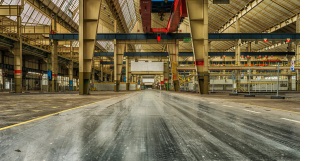Jigs and Fixtures: 3D Printing on the Factory Floor
 As we move deeper into the Fourth Industrial Revolution (or Industry 4.0), it becomes increasingly important that companies adopt new technology and innovate – or risk getting left behind. From automotive and aerospace to medical and consumer goods, industries have changed the way they work to create smarter and more efficient processes and products. 3D printing has been a strong driving force in this revolution and is now gaining prominence on factory floors for its ability to create manufacturing tools like jigs and fixtures faster and more efficiently. Here’s how 3D printing is changing the factory floor.
As we move deeper into the Fourth Industrial Revolution (or Industry 4.0), it becomes increasingly important that companies adopt new technology and innovate – or risk getting left behind. From automotive and aerospace to medical and consumer goods, industries have changed the way they work to create smarter and more efficient processes and products. 3D printing has been a strong driving force in this revolution and is now gaining prominence on factory floors for its ability to create manufacturing tools like jigs and fixtures faster and more efficiently. Here’s how 3D printing is changing the factory floor.
3D Printing Creates Custom Solutions
One of the biggest benefits of 3D printing, across industries, is its ability to create custom solutions at a lower cost than traditional methods. Doctors have used 3D medical models to improve patient outcomes, for example, while 3D printing in the automotive industry has yielded custom, multi-material parts. This customization is largely possible due to the wide range of 3D printing materials available, and the enhanced properties that make them suitable for many applications. This includes materials like Nylon 12CF and Ultem 1010.
Nylon 12CF
Nylon 12CF is a 3D printing nylon with a very high stiffness-to-weight ratio and can be used to replace more typical tooling materials like aluminum. Nylon is capable of producing tough parts with superior fatigue and chemical resistance, including drill guides, bracketry, end-of-arm tooling, jigs, and fixtures.
Ultem 1010
Ultem 1010 is a high-performance thermoplastic with strength and thermal stability. The material is capable of withstanding steam autoclaving and has food-contact and biocompatibility certifications, making it well-suited for the medical and food production industries.
These materials, among others, have encouraged the adoption of 3D printing in various industries and continue to inspire innovation and custom solutions.
3D Printing Makes Manufacturing Tools Faster
These enhanced materials and customization capabilities are especially useful when creating manufacturing tools like jigs and fixtures.
What is a Jig? What is a Fixture?
A jig is a “tool that guides the cutting (or machining) tool,” while a fixture is defined as “a tool which holds the workpiece with the machine bed precisely at the desired location.” According to a Stratasys solution brief, jigs and fixtures can reduce scrap and rework, direct labor time, and strain while improving process throughout, control, and repeatability, but companies can’t always justify the expense.
How Does 3D Printing Change How Jigs and Fixtures are Used?
Additive manufacturing helps justify the cost of using jigs and fixtures by creating high-quality tools at a lower cost, and with a shorter lead time. Stratasys revealed that companies that use 3D printing to create manufacturing tools can save 70 to 90 percent in costs and 40 to 90 percent in lead time reduction when compared to outsourcing fixtures.
Optimize Performance
Once jigs, fixtures, and other manufacturing tools are created with additive manufacturing it’s easy to make adjustments. While remanufacturing with traditional methods can be costly and time-consuming, 3D printing allows companies to redesign and reprint their tools within a day.
Some 3D printers, like the Fortus 900, are even made specifically with the factory floor in mind. These printers are designed to deliver superior throughput and reliability for the creation of robust factory tooling, jigs, and fixtures.
Bring 3D Printers to the Factory Floor
Whether you want to leverage the enhanced capabilities of 3D printing materials for custom solutions or create your own jigs and fixtures in-house, a 3D printer on the factory floor will help you keep up with competitors and drive innovation. If you’re interested in what 3D printing can do for you, contact our 3D printing experts for more information.
Related Articles
The Best Software for the 3D Printing Professional: SOLIDWORKS and GrabCAD Print
What to Look for in a 3D Printer: The Best 3D Printers by Industry
3D Printing Uses in Business: How are Top Companies Taking Advantage of 3D Printing Technology?
About the Author
 Lisa Hannon is a marketing manager at Fisher Unitech. She develops content for 3D printing topics that have an impact across all industries that are researching ways to maximize getting products to market faster as well as cost savings with 3D printing solutions. Lisa has worked as a marketing management professional since 1998, most recently with Stratasys.
Lisa Hannon is a marketing manager at Fisher Unitech. She develops content for 3D printing topics that have an impact across all industries that are researching ways to maximize getting products to market faster as well as cost savings with 3D printing solutions. Lisa has worked as a marketing management professional since 1998, most recently with Stratasys.

 Blog
Blog